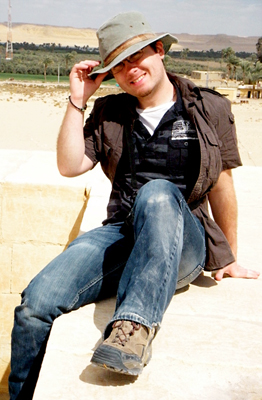Live Interpretation Manager of Historic Royal Palaces and King Arthur Expert Christopher Gidlow is the Live Interpretation Manager of Historic Royal Palaces. He specialises in bringing history to life at the Tower of London, Hampton Court Palace, Kensington Palace and the Banqueting House Whitehall. He is also responsible for interpretation on the project to open the Georgian Kitchens of Kew Palace to the public. He is also a director of the International Museum Theatre Alliance (Europe). A life-long enthusiast for the Arthurian legends, Christopher describes being told by his primary teacher that they might have a basis in fact as…
-
-
Egyptologist 11 November 1942 Dr Rolf Krauss is a renowned German Egyptologist who – prior to retiring in 2007 – last worked as a researcher at the Berlin Museum of Prehistory and Early History, and as a lecturer at Humboldt University. He has produced a number of important studies into ancient Egyptian chronology and astronomy. Born in Heidelberg in 1942, Dr Krauss studied at the University of Heidelberg and the Free University of Berlin from 1975 to 1981, gaining his PhD in Egyptology from the latter institution. He went on to work at the Egyptian Museum in the National Museums…
-
Geoff Holder Author and forteana expert Geoff Holder is the author of more than a dozen books on everything mysterious, paranormal, strange, gothic and grotesque. His books are an authoritative mix of extensive historical study combined with diligent field research. They are often geographically-based, with titles such as The Guide to Mysterious Glasgow and The Guide to the Mysterious Lake District. Holder is primarily interested in ‘forteana’ – the world of the odd, the curious, the wondrous, the allegedly paranormal – and its fractious and informing relationship with the so-called mundane world. What do people do when they have too…
-
Attribution: Photo by Maggie Bryson Garry Shaw Egyptologist and writer 7 April 1981 Dr. Shaw studied archaeology at the University of Liverpool from 1999 – 2002, and then stayed on in Liverpool to study for an MA (2002 – 2003) and PhD (2004 – 2008) in Egyptology, only taking a year off to go explore China. His main area of research has been elite life and architecture in Egypt’s New Kingdom, with the extent of the pharaoh’s personal authority in day-to-day political affairs being the subject of his first book, published in 2008. Subsequently he has written academic articles on…
-
Yuval Peleg Israeli Antiquities Authority’s head district archaeologist for the Jordan Valley Israeli Antiquities Authority archaeologist Yuval Peleg is the head district archaeologist for the Jordan Valley. His excavations at Qumran, conducted mainly from 1993-2004, have brought him into the middle of the debate raging over the Dead Sea Scrolls. He worked alongside fellow archaeologist Yitzhak Magen. The two of them found that the site was not an Essene settlement and that the scrolls were deposited in nearby caves by refugees fleeing the Roman army, after the fall of Jerusalem, in 70 A.D. Peleg holds an MA in archaeology from the…
-
What lies behind the legends of King Arthur? Fragments of history, or just wishful thinking? While historians study the ancient manuscripts, modern archaeologists join in the hunt for clues. From Arthur’s ‘birthplace’ at Tintagel to the fabled ‘Isle of Avalon’, we sift through the evidence. Journeying across Arthur’s Britain, we search for Camelot and the sites of his battles. Do the remains confirm or contradict the traditional accounts? Far from providing objective proof, Christopher Gidlow shows how archaeologists’ interpretation of their discoveries reflects the academic fashions of their times. Sites which in the 1960s were used to prove King Arthur’s…
-
Professor of Egyptology at the American University in Cairo Dr Salima Ikram – one of the world’s leading authorities on Egyptian religion – recently chatted to Heritage Key on the subject of the cult of animal worship in ancient Egypt. In another exclusive new video interview, she dons her white coat and takes us to the lab, for a fascinating insight into the practice of animal mummification. Animals were deeply sacred in ancient Egypt, particularly from the 26th dynasty – around 700 BC – until the end of Egyptian civilization and the advent of Christianity by 400 AD. They were…
-
Beltane was an ancient Celtic festival which welcomed in the summer, celebrated before the Romanisation of Britain. It was honoured with fires, livestock breeding and marriage ceremonies. Today’s Beltane Fire Festival takes place on the 30th April on Calton Hill in Edinburgh, and while a paean to the ancient traditions of the nation, is nothing more than a supposed resurrection of what happened all those years ago. The festival consists mainly of an incendiary procession whereby mytical characters like the Mary Queen, Green Man and Red Man are summoned, burned and resurrected. A fire arch and special bonfire are also…
-
People of the Earth An Introduction to World Prehistory by Brian Fagan The 13th edition of this internationally renowned text provides the only truly global account of human prehistory from the earliest times. Written in an accessible way, People of the Earth shows how today’s diverse humanity developed biologically and culturally over millions of years against a background of constant climatic change. Brian Fagan is one of the leading archaeological writers in the world and an internationally recognised authority on world prehistory. He studied archaeology and anthropology at Pembroke College, Cambridge University, and then spent seven years in sub-Saharan Africa working in…
-
The Roman Forum by David Watkin A radically new look at the ruins of the centre of ancient Rome. The Roman Forum may be a highlight of the tourist route in Rome, but many visitors still find it a baffling and unwelcoming place. There can be few more historic places in the world. Caesar was cremated there. Charles V and Mussolini rode by it in triumph. Napoleon celebrated his Festival of Liberty there. David Watkin’s Forum is the site as it was famous for centuries, celebrated in the romantic views of the Grand Tour, not the archaeologists’ building site it…




